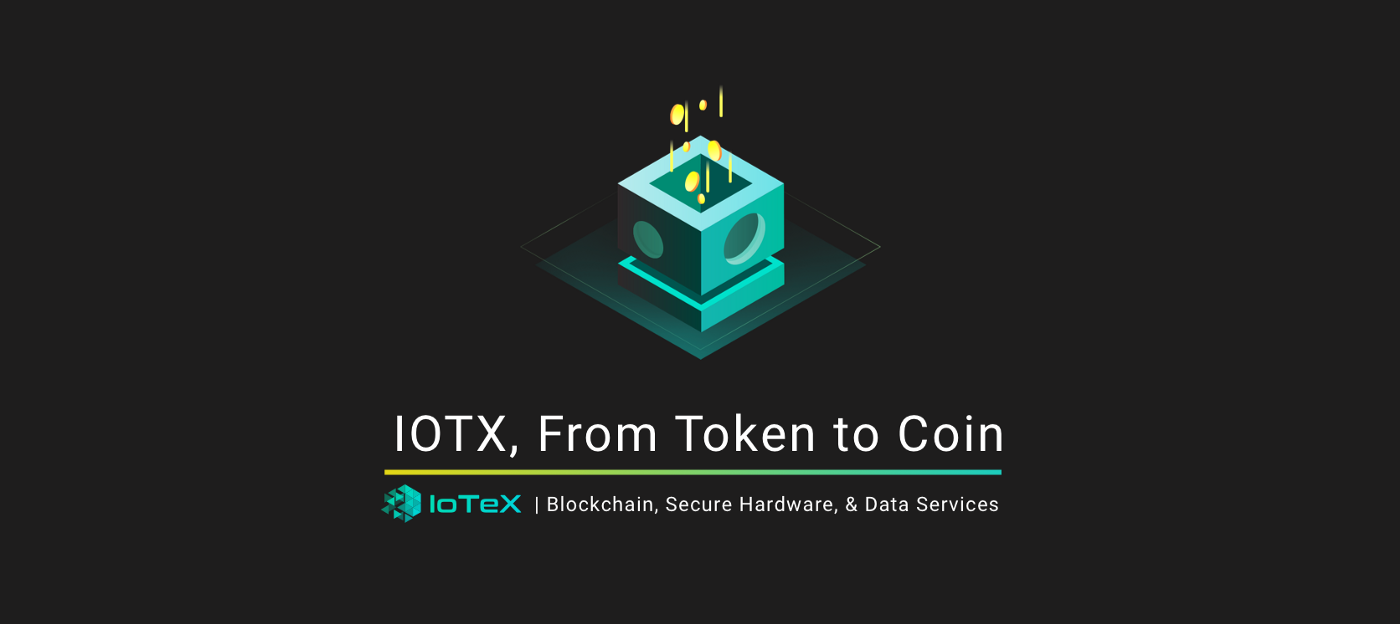
IOTX, From Token to Coin
Given the level of IoTeX platform maturity and the subsequent increase in IoTeX blockchain based applications, the time has come to initiate the token swap from IOTX-E to IOTX . This article summarizes our plan for the token swap process and aims to clear up any confusion our token holders may have.
The IoTeX mainnet first launched in April, 2019 and has since run for around 10 months with 6 major upgrades from version 0.5 to version 0.10 while successfully processing over 3 million transactions. Given the level of IoTeX platform maturity and the subsequent increase in IoTeX blockchain based applications, the time has come to initiate the token swap from IOTX-E (the ERC20 version of IoTeX token which is overwhelmingly used and traded as of now) to IOTX (the IoTeX blockchain’s native coin). This article summarizes our plan for the token swap process and aims to clear up any confusion our token holders may have.
Token Swap Channels
There are two channels for users/developers to swap IOTX-E for IOTX: 1. via exchanges and 2. via IoTube — a cross-chain two-way facility developed by us. Users are free to use both channels to convert IOTX-E to IOTX. Both channels will be available for 3 months and once more than 95% IOTX-E are successfully swapped we will pause the ERC20 contract and finally retire IOTX-E.
Exchange Support of Token Swap
Starting in January, 2020 crypto exchanges will gradually move to use IOTX (rather than IOTX-E). The crypto exchanges that already support IOTX (as of the time of writing) are: Gate, Kucoin, Hotbit and Piexgo. Among them, Gate and Piexgo support the deposit of both IOTX-E and IOTX, and can be used to convert IOTX to IOTX-E. Binance and other exchanges are working on integrating with IoTeX blockchain, and if you have IOTX-E there, they should be taken care of.
For other exchanges that need to integrate with IoTeX blockchain, please follow this guide.
Use IoTube to Swap Tokens
The IoTeX Foundation has built tools for the community to freely swap between IOTX-E and IOTX — IoTube. In the coming 3 months, we highly recommend the community to start holding, using, and staking Native IOTX.
- Swap IOTX-E to IOTX: swap IOTX-E (ERC20) to IOTX (Native) with just a few clicks; recommended for all IOTX-E token holders
- Swap IOTX to IOTX-E: although this capability exists, we recommend the community to start holding, using, and staking Native IOTX
⚠️ Note: every Ethereum Address (“0x…”) has a corresponding IoTeX Address (“io…”) which shares the same private key (see here). Make sure you have the private key of any ETH/IOTX Address you swap to — do NOT swap to an exchange account! ⚠️
Phase Out Cross-chain Governance
Previously, IoTeX blockchain embraced a new paradigm called “cross-chain governance” to bootstrap, which basically means staking and voting are happening on Ethereum blockchain while the governance results are applied to IoTeX blockchain for its operation. Since IoTeX blockchain has been bootstrapped for ~10 months, we are confident enough to migrate away from cross-chain governance model.
Specifically, in Q1 of 2020, we will slowly and safely migrate staked IOTX-E on ethereum (within the contract 0x87c9dbff0016af23f5b1ab9b8e072124ab729193) to staked IOTX on native IoTeX blockchain without interrupting the operation of Roll-DPoS. The initial plan is:
- Enable self-staking and delegates registration on IoTeX blockchain;
- Incentivize delegates to migrate from Ethereum to IoTeX blockchain (we expect the majority of delegates with their voters to migrate);
- For the remaining delegates on Ethereum, implement a mapping contract on Ethereum so a delegate can bind an io address with its own delegate address (which is an Ethereum address);
- Freeze 0x87c9dbff0016af23f5b1ab9b8e072124ab729193@Ethereum and copy its states together with the states of the mapping contract, merge them and deploy to the staking contract on the native chain to finish the final migration.
Conclusion
As the swapping proceeds forward, the true utility of IOTX will be manifested. Generally speaking, there are three categories of utility for IOTX:
- Decentralized governance: staking/voting for Delegates, Delegate rewards and slashing (upcomings), and network-wide votes/referendums (i.e., changes to rules, parameters, protocols)
- Fees for storage and compute: running transactions and executing smart contracts on the IoTeX Network cost fees. These fees are collected by the blockchain as a “tax” which will be used to reward future block producing delegates
- Bond/operation costs for L2 components: to provision and operate a Layer 2 component (e.g., subchains, identity providers, trust computing unites), one must stake IOTX on the chain as bond and pay for operational costs and will be slashed if proved to misconduct layer 2 components.
First manifestations of “Decentralized governance” and “Fees for storage and compute” are already in use. We are focusing on designing and implementing crypto economics and utility of “Bond/operation costs for L2 components”. Concretely, we launched Ucam in CES2020 which will hit the mass market in March 2020, the DID provider of which is considered as an L2 component and will be fueled with IOTX! Stay tuned for the update!
About IoTeX
Founded as an open source platform in 2017, IoTeX is building the Internet of Trusted Things, where all physical and virtual “things” — humans, machines, businesses, and DApps — can exchange information and value at global scale.
Backed by a global team of 30+ top research scientists and engineers, IoTeX combines blockchain, secure hardware, and decentralized identity to empower intelligent IoT networks and machine economies. By serving as a decentralized trust fabric for IoT, IoTeX will empower the future decentralized world by “connecting the physical world, block by block”.
Subscribe
Subscribe to get the latest posts from IoTeX Blogs delivered to your inbox.